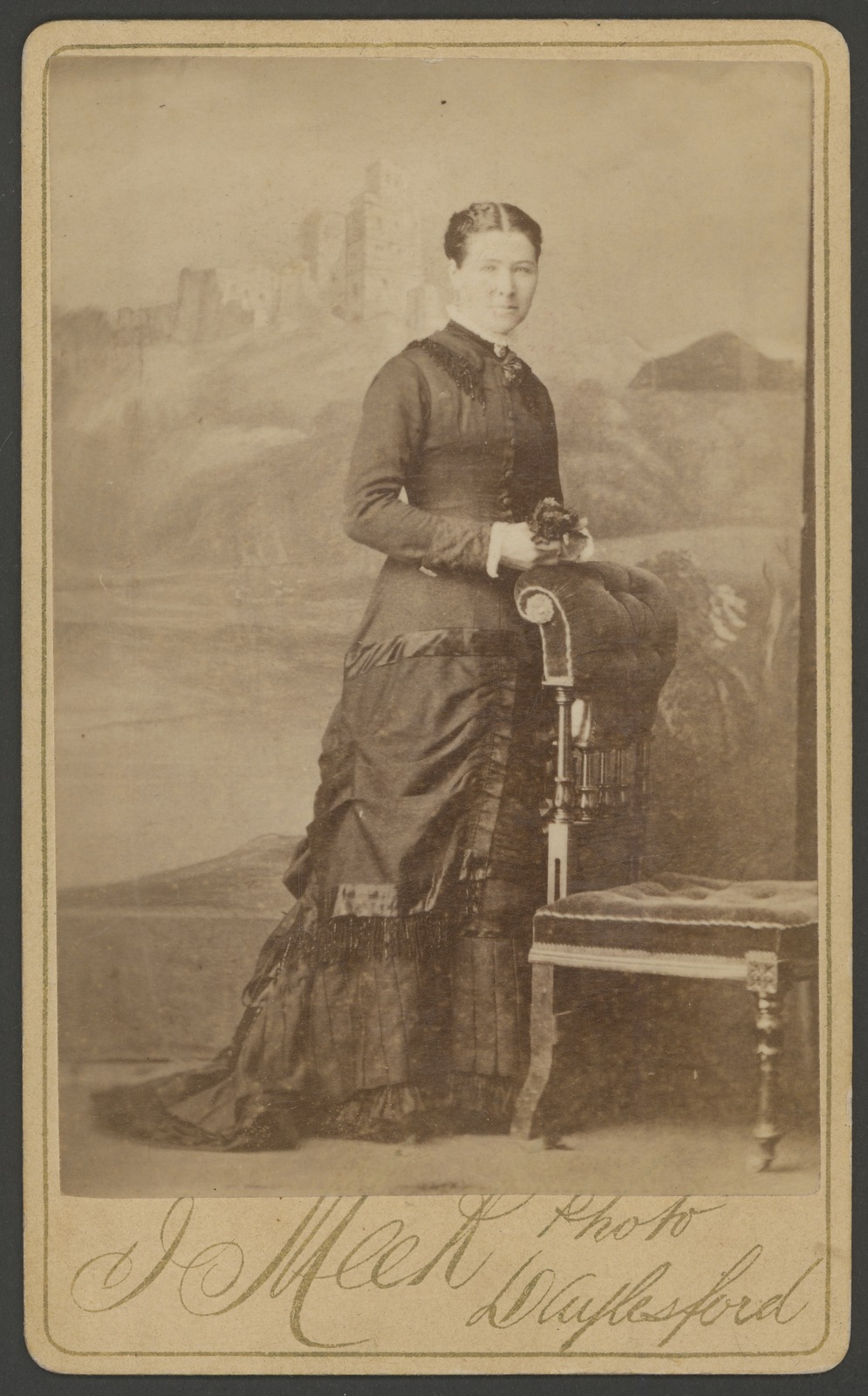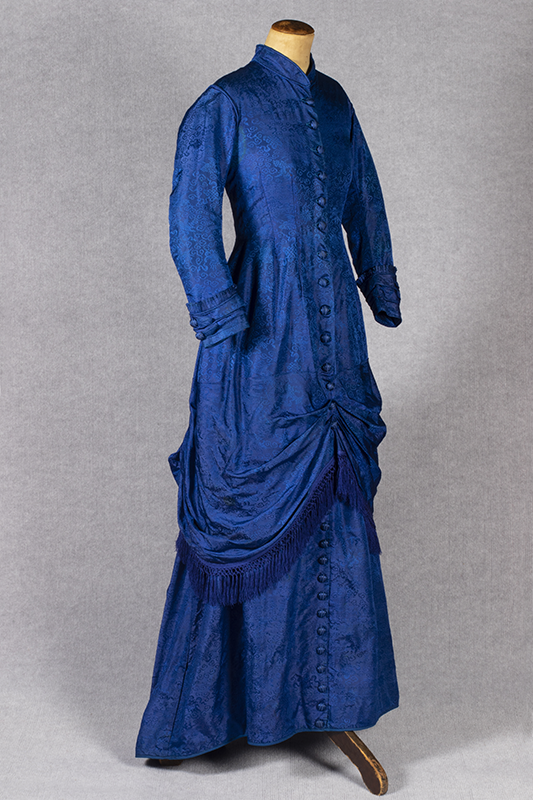
A royal blue silk dress dating to around 1880 in the collection of the Brighton Historical Society is connected to a family who arrived on the Victorian goldfields at the height of the gold rush in the 1850s and continued to live in and around the town of Bendigo for the remainder of the nineteenth century. This dress reflects the growth of a prosperous gold rush town from an initial settlement of thousands of gold-diggers' tents to a substantial and organised metropolis with thriving drapers and dressmaking businesses. It also indicates that fashions were astutely followed in the booming Australian townships of the 1870s and 1880s.
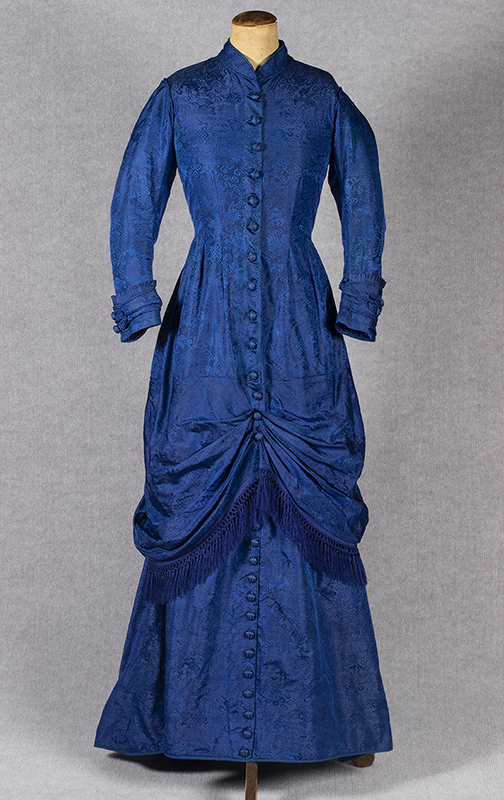 |
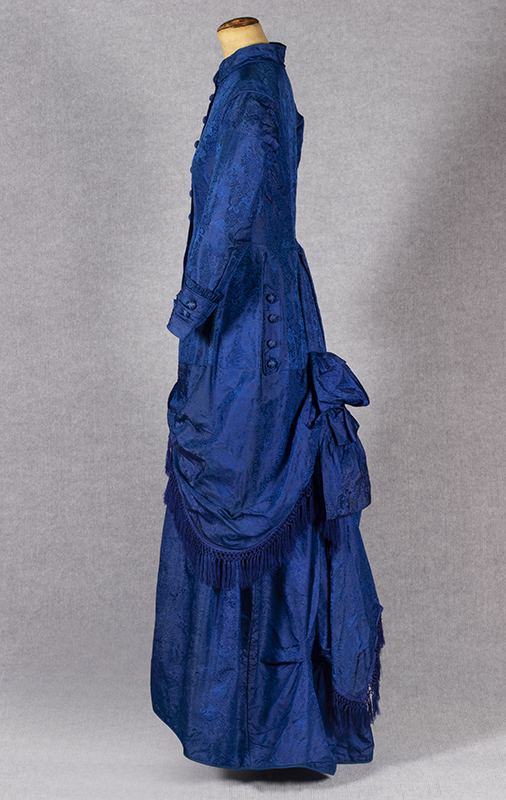 |
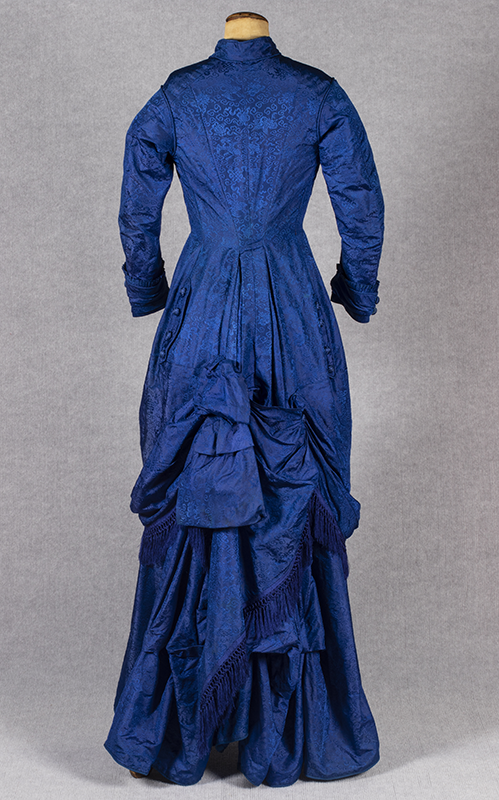 |
Australia, Day dress, c.1880 |
Prior to the discovery of gold in Central Victoria in 1851, the colony (which was a part of New South Wales until 1851) had derived its wealth from pastoral settlement. With the influx of gold-seekers arriving from Britain, America, Europe and China, the population of the newly founded colony of Victoria swelled from 77,345 in 1851 to 540,322 in 1861. A large proportion of these immigrants were lured to the goldfields in the hope of striking it lucky. Many, however, found that the money lay in supplying goods to the diggers and their families and early stores began in tents which could be shifted around the goldfields as the population moved to newly discovered strikes.
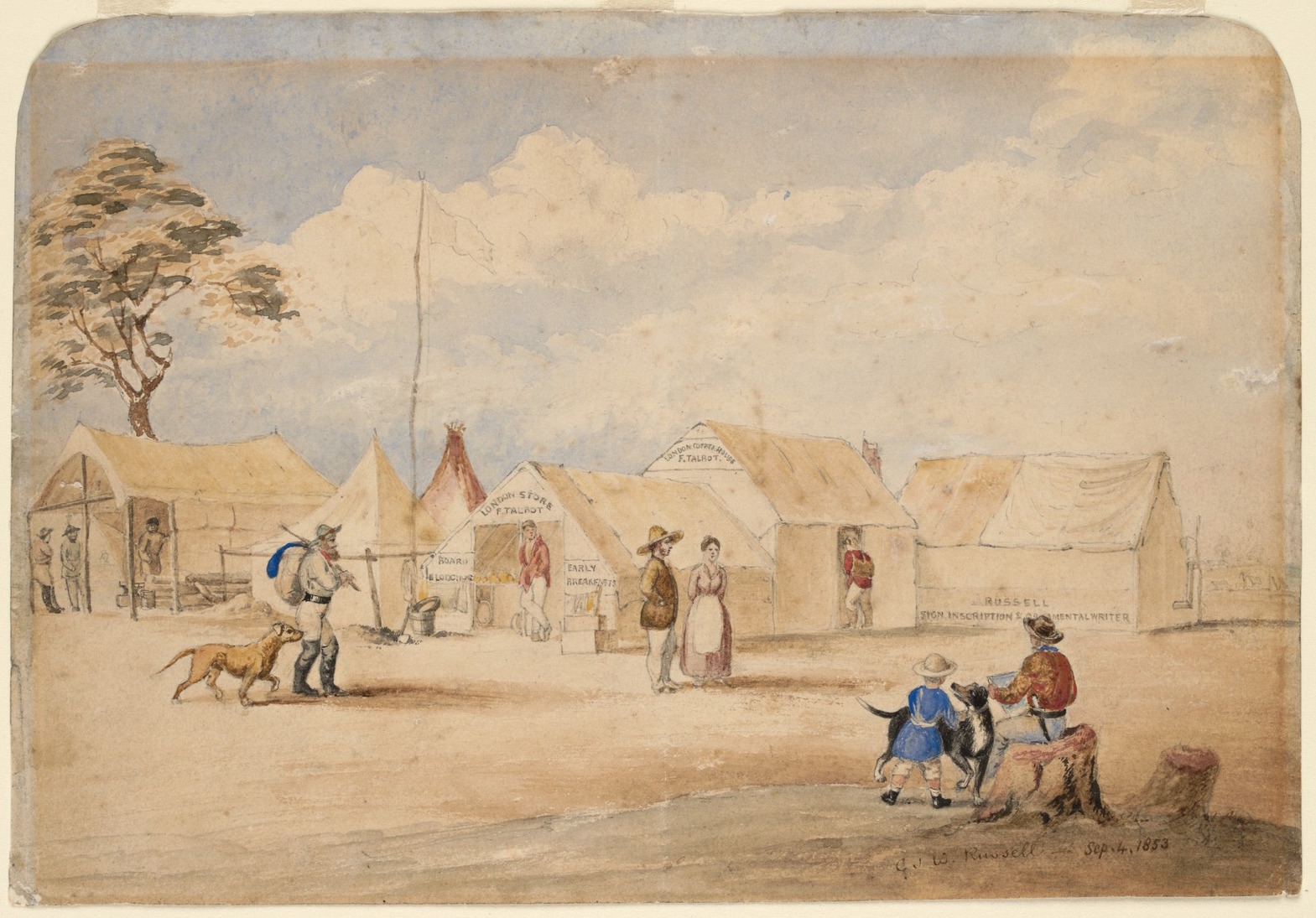 |
C. J. W. Russell White Hills, Bendigo, Victoria, 1853 watercolour on paper State Library of Victoria. Public Domain. |
While the quintessential image of the gold digger was a man dressed in a red or blue flannel shirt, moleskins, boots and wide-brimmed hat, women and children were very much present on the goldfields, living and working alongside their menfolk. The blue silk dress is believed to have been worn by Elizabeth Moore, née Holliday, who was born in Spring Gully near Bendigo in 1860. Elizabeth's parents, James Holliday and Amelia Hayward (also spelled Haywood) were married in Bendigo (then known as Sandhurst) in 1859 and appear to have lived in the area for the rest of their lives. Elizabeth was the oldest of ten children born between 1860 and 1884 and would have been about twenty years old when she wore this dress on the streets of Bendigo.
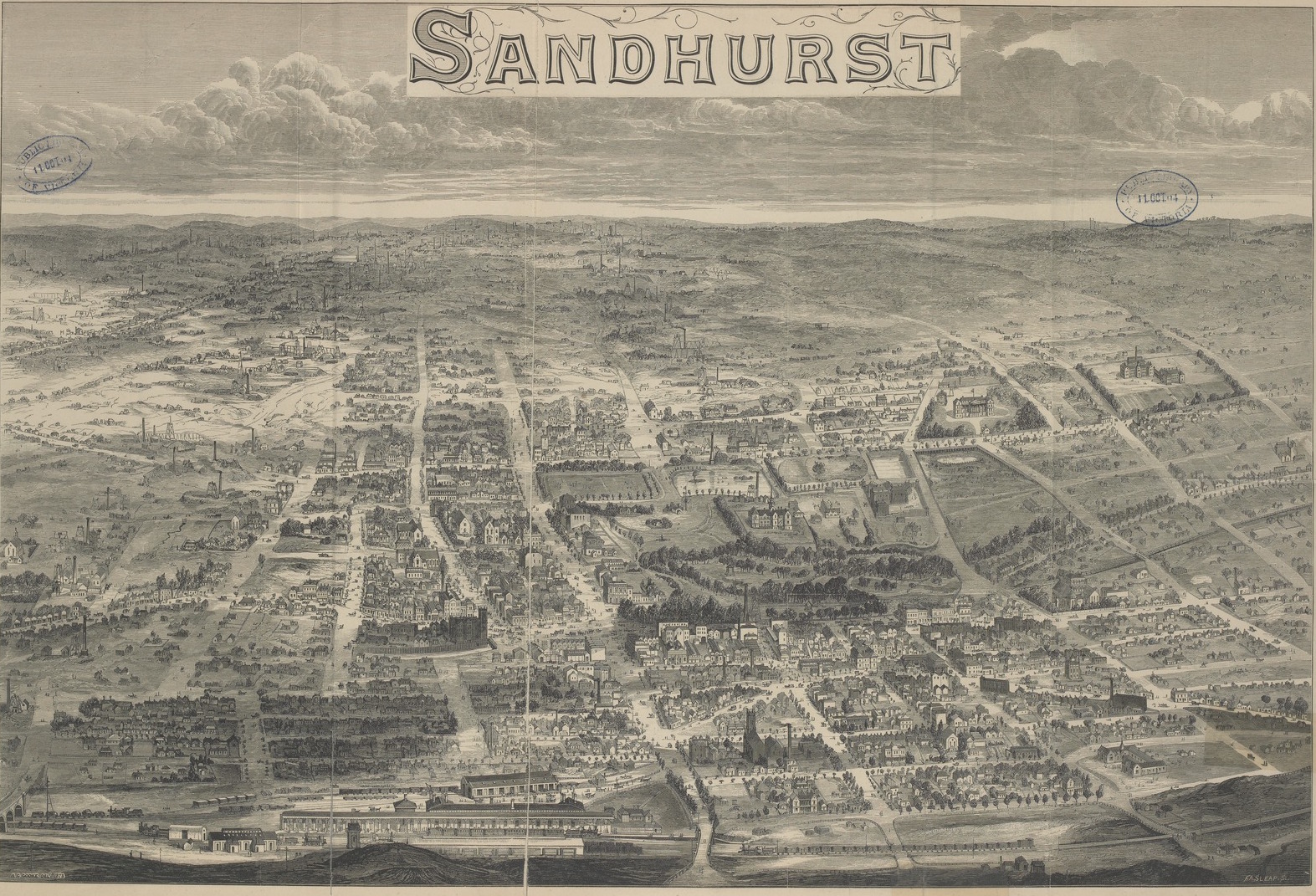 |
A. C. Cooke, engraver Sandhurst, 1878 wood engraving State Library of Victoria. Public Domain. |
During the gold rush, the Victorian goldfields towns of Ballarat and Bendigo swelled in population, vying with Melbourne in importance. Permanent stores and dwellings were erected and the towns took shape. Grand Victorian buildings graced wide streets and the well-laid out civic centres and public gardens catered for a cosmopolitan population, many of whom made the goldfields region their permanent home.
Elizabeth's dress provides a stark contrast to the stereotype of the Australian gold digger who wore rough working clothes. While it was often believed that little in the way of fashion was available in these country areas, the presence of a large number of people, including women and children, spurred trade and those with disposable income did indeed seek the latest fashions. Visitors to the goldfields in the 1850s commented on the array of fashions worn by the women. In 1853 William Howitt found the women in Bendigo to be more neatly attired than in Britain, stating, "many of them came out in an afternoon as well dressed as they need be to walk abroad in London. There was no lack of handsome mantillas, jackets, smart bonnets, and parasols."
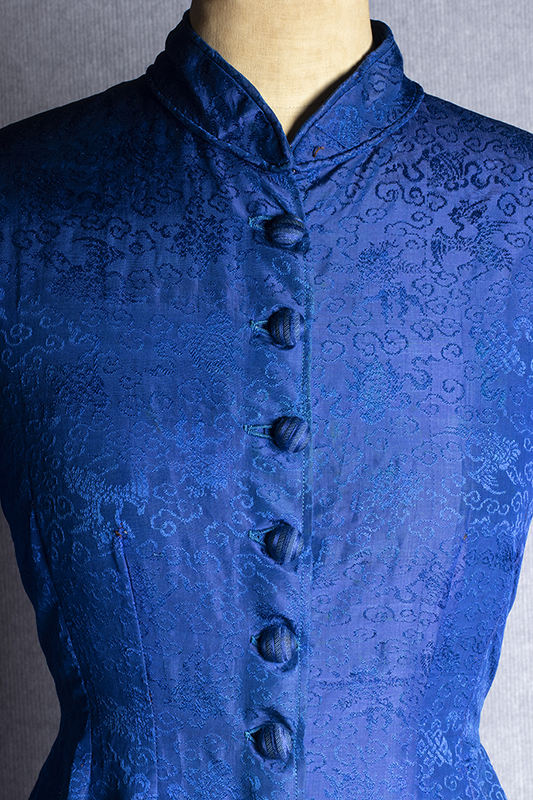 |
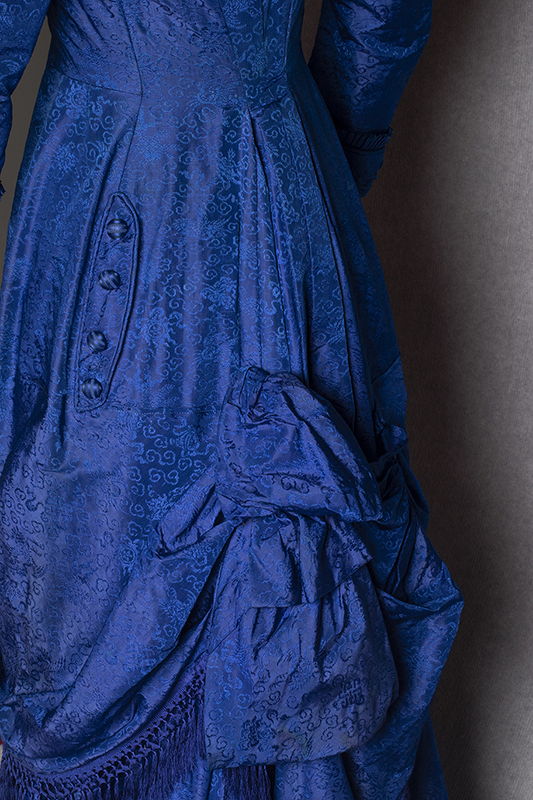 |
Australia, Day dress, c.1880 |
Since little in the way of ready-made clothing was available for women in the nineteenth century, dresses were either made to measure by a dressmaker or by women in the home. Around the time Elizabeth's dress was made, the Lyceum Mutual Drapery Cash Store was advertising its "large and carefully selected stock of new and fashionable drapery suitable for the present season." On the same page of the Bendigo Advertiser's edition of 2 January 1880, Taylor Bros. and Co. in Pall Mall, Sandhurst, announced that they "beg to inform the public that their dressmaking department is under the management of Mrs. Stephens." With "fit guaranteed", ladies could have their own dress materials made up. This may have been the case for Elizabeth's dress and, if she so desired, she could have purchased suitable millinery and accessories in the same store to complete the outfit.
The one-piece princess-line cut of this dress was in fashion for a relatively short period of time from 1876 to 1882. The fullness at the back, which is controlled by interior tapes, was supported by a separate bustle which was worn along with petticoats and a tightly-laced corset. The silk is woven with a Chinese-influenced design of scrolling cloud bands. With cart and train loads of goods arriving from the ports of Melbourne and Geelong, the fabric would have been imported through agents located in London or through trade networks in Asia.
Elizabeth married Richard Moore in 1896 and the couple lived in Brighton, where their daughter Georgiana was born in 1899. The family moved to Diamond Creek for several years, but returned to Brighton after Richard's death in 1922. Georgiana and her mother settled in Cochrane Street, Brighton, where they lived for the rest of their lives, with Elizabeth dying in 1950 and Georgiana in 1974. The dress was donated to the Brighton Historical Society in 2003 by Georgiana's niece, who believed the dress had been worn by her aunt. However, given its very specific style, which dates it to about 1880, it was most likely worn by Elizabeth.
Laura Jocic, 2019
Page design by Jessica Curtain
References
Bate, Weston, Victorian Gold Rushes, McPhee Gribble, Fitzroy, 1988.
Blum, Stella (ed.), Victorian Fashions and Costumes from Harper's Bazar, 1867-1898, Dover Publications, New York, 1974.
Byrde, Penelope, Nineteenth Century Fashion, B. T. Batsford, London, 1992.
"Drapery, Clothing, &c.", Bendigo Advertiser, 2 January, 1880, p.1.
Howitt, William, Land, Labour, and Gold or Two Years in Victoria with visits to Sydney and Van Diemen's Land. Vol. I. Longman, Brown, Green, Longmans, and Roberts, London, 1858.
Mackay, George, History of Bendigo, Lerk and McClure, Bendigo, 2000 (first pub. 1891).
Acknowledgements
Thanks to Jessica Curtain for her work on the Holliday and Moore family dates and locations.
This research was funded by a Local History Grant from Public Record Office Victoria.
Brighton Historical Society Costume Collection Project, 2018-2019.

